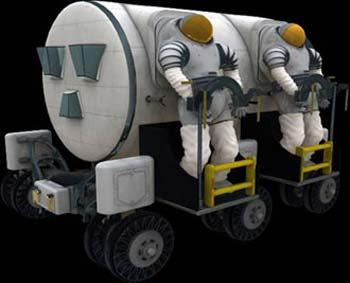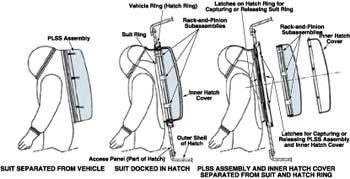Source: nasa
09-18-2008 16:41
This list contains all spacewalks and moonwalks where an astronaut has fully, or partially left his spacecraft. All spacewalks have had the astronauts tethered to their spacecraft except for seven spacewalks by the United States, (six in 1984 using the Manned Maneuvering Unit, one in 1994 testing the SAFER rescue device).
 |
| A NASA concept drawing of a lunar rover featuring suitports. |
All moonwalks saw astronauts untethered, and some had astronauts traveling far enough to lose visual contact with their craft (they were up to 7.6 km away from it using the Lunar Rover). As of October 26, 2007, 168 astronauts had made spacewalks (out of 464 astronauts who have gone into space). Only 10 women have been on spacewalks, at least partly because the EVA suits are designed for a larger male frame.
Operation
In a suitport system, a rear-entry space suit is attached and sealed against the outside of a spacecraft, space habitat, or rover. To go on an extra-vehicular activity (EVA), an astronaut first enters the suit from inside the vehicle, and closes and seals the space suit backpack and the vehicle's hatch (which seals to the backpack for dust containment). The astronaut then unseals and separates the suit from the vehicle, and is ready to perform an EVA.
To re-enter the vehicle, the astronaut backs up to the suitport and seals the suit to the vehicle, before opening the hatch and backpack and transferring back into the vehicle. If the vehicle and suit do not operate at the same pressure, it will be necessary to equalize the two pressures before the hatch can be opened.
 |
| Diagram of a suitport system |
Advantages
Suitports carry two major advantages over traditional airlocks. First, the mass and volume required for a suitport would be significantly less than that required for an airlock. Launch mass is at a premium in modern chemical rocket-powered launch vehicles, at an estimated cost of US$60,000 per kilogram delivered to the lunar surface.
Secondly, suitports can eliminate or minimize the problem of dust mitigation. During the Apollo program, it was discovered that the lunar soil is electrically charged, and adheres readily to any surface with which it comes into contact, a problem magnified by the sharp, barb-like shapes of the dust particles. Lunar dust may be harmful in several ways:
1. The abrasive nature of the dust particles may rub and wear down surfaces through friction
2.The dust may have a negative effect on coatings used on gaskets to seal equipment from space, optical lenses that include solar panels and windows as well as wiring
3.The dust may cause damage to an astronaut's lungs, nervous, and cardiovascular systems
During the Apollo missions, the astronauts donned their space suits inside the Apollo Lunar Module cabin, which was then depressurized to allow them to exit the vehicle. Upon the end of EVA, the astronauts would re-enter the cabin in their suits, bringing with them a great deal of dust which had adhered to the suits. Several astronauts reported a "gunpowder" smell and respiratory or eye irritation upon opening their helmets and being exposed to the dust.
With a suitport, dust or other environmental contaminants cannot enter the cabin of the vehicle. When the suit is attached to the vehicle, any dust which may have adhered to the backpack of the suit is sealed between the outside of the backpack and the vehicle-side hatch. Any dust on the suit that is not on the backpack remains sealed outside the vehicle. Likewise, the suitport prevents contamination of the external environment by microbes carried by the astronaut.
Development and future use
Patents for suitport designs were filed in 1996 by Philip Culbertson Jr. of NASA's Ames Research Center,and in 2003 by Joerg Boettcher, Stephen Ransom, and Frank Steinsiek.
Suitports may find use as part of future NASA projects aimed at achieving the Vision for Space Exploration, which calls for a return to the Moon and eventual manned exploration of Mars.
Editor:Yang Jie
